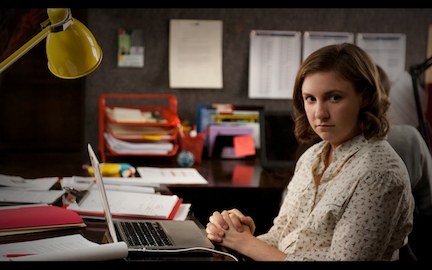Why Bad Sex Is Good—On HBO's "Girls"

WMC's Madeleine Gyory argues that the new HBO show makes room for realistic complications of forging sexual relationships.
The new HBO series “Girls” chronicles the experiences of four girlfriends living in New York City. So comparisons to “Sex and the City”—that other HBO series that chronicled four women living in NYC—were inevitable.
The New York Times entitled its initial review, “There’s Sex, There’s the City, but No Manolos.” In it, columnist Alessandra Stanley wrote “‘Sex and the City’ served up romantic failure wrapped in the trappings of success. ‘Girls’ offers romantic failure wrapped in the trappings of failure.”
Entertainment Weekly's Hillary Busis concluded that “Girls” is “both more audacious and less assured than ‘Sex and the City.’” None of the “woefully ignorant” characters in “Girls,” she wrote, “has much experience with sex, let alone its consequences.” (One scene shows the main character, Hannah, googling “stuff that gets up around the sides of condoms”).
But this is precisely the quality that endears the show to its young viewers. The characters of “Girls” are ten years younger than their “Sex and the City" counterparts, allowing for a fresh perspective on sex and sexuality. Perhaps more significantly, “Girls” is created, written, directed, and produced by 25-year-old Lena Dunham, who also stars in the show. SATC, although inspired by Candace Bushnell’s column, was created and written primarily by men.
The four young women of “Girls” are quite removed—ideologically, geographically (most of them live in Brooklyn), and economically—from the glamorous, sexually experienced women of SATC. And despite what Katie Roiphe wrote in her Slate commentary, sexual identity does not emerge, fully developed, in a day. “Is sex always as unfun or awkward as it is on the show?” asked Roiphe. The answer is no, but sometimes it is. And it’s refreshing to see that side of young women’s sexual experiences discussed and shown in visual media.
The show refuses to “romanticize youth,” wrote Meghan Daum in the Chicago Tribune: “[T]he fleshy, awkward and seriously cash-strapped Hannah is so real you sometimes can only peer at her through your fingers.” But it’s not just Hannah’s awkwardness that makes her so hard to watch. It’s also how the “unapologetic casual sex” she engages in can be humiliating, uncomfortable, and just plain ridiculous.
In New York magazine, Emily Nussbaum wrote that the show “presented sex as a rough draft, a failed negotiation, at once hilarious and real.” One twitterer put it quite succinctly during #SheParty, WMC’s weekly Twitter happy hour: “That [sex] scene was messed up in how wrong it was, but so very right in how accurate it is.”
I don't see the sex in “Girls” as a statement on some universal, essentialized sexual phenomenon (even within the white, young, privileged world it exists in). If it is a statement at all, it comments on the complexities of sexuality, a theme usually overshadowed in favor of smooth bodies and flattering lighting. We rarely get to see this other side of sexuality: the less-than-perfect sex. The bad sex. The humiliating sex.
But “Girls” also makes a statement on pleasure, satisfaction, and desire. The start of the second episode shows two vastly different sex scenes, one of Hannah in bed with her selfish and crass nonboyfriend Adam, and the other of Hannah’s roommate, Marnie, with her sweet and respectful long-term boyfriend, Charlie. The two scenarios share a common theme: both women are dissatisfied. These vastly different scenes both depict women not getting what they want. And here is my point: sex isn’t as simple and clean as the steady stream of screaming orgasms that is SATC.
As a friend put it in an email:
“Girls” shows us the way sex can be humiliating and uncomfortable, awkward and occasionally brutal, but also completely human, which is a rare balance. I wouldn't say I enjoy watching the sex scenes, but they make me nod in recognition, and feel understood.
The sex in “Girls" is not realistic merely because it is “bad.” It says something far more interesting: that sex is an exchange. More than a performance, it involves individuals giving and taking. One wishes it weren’t novel to see sex depicted as something complicated, involving two people navigating their own desires and expectations while simultaneously interpreting those of another person.
The sex in “Girls” shows how difficult that navigation can be. We cringe because we see up close what happens when communication fails and expectation meets reality. Those elements that make sex scenes so sexy—intuition, eroticism, chemistry—are conspicuously absent from “Girls.” We're left with four girlfriends each attempting to understand her own inhibitions, desires, and emotions. And that’s refreshing.
More articles by Category: Arts and culture, Feminism, Girls
More articles by Tag:



























